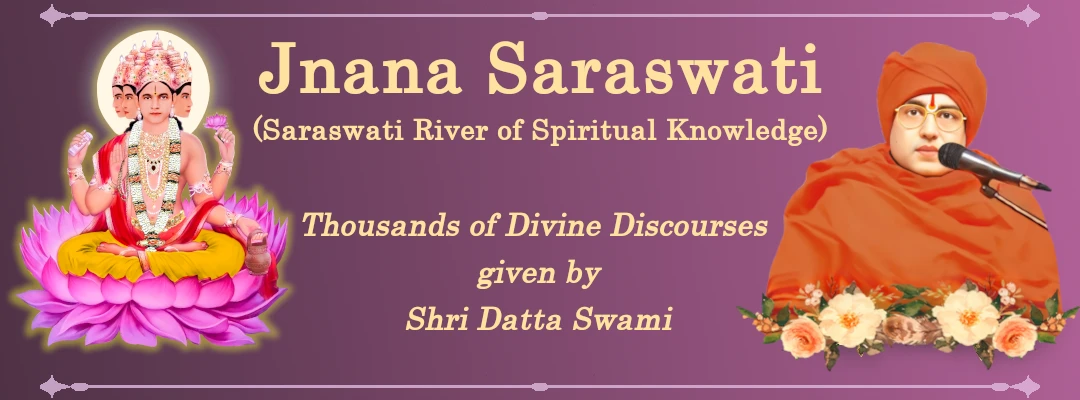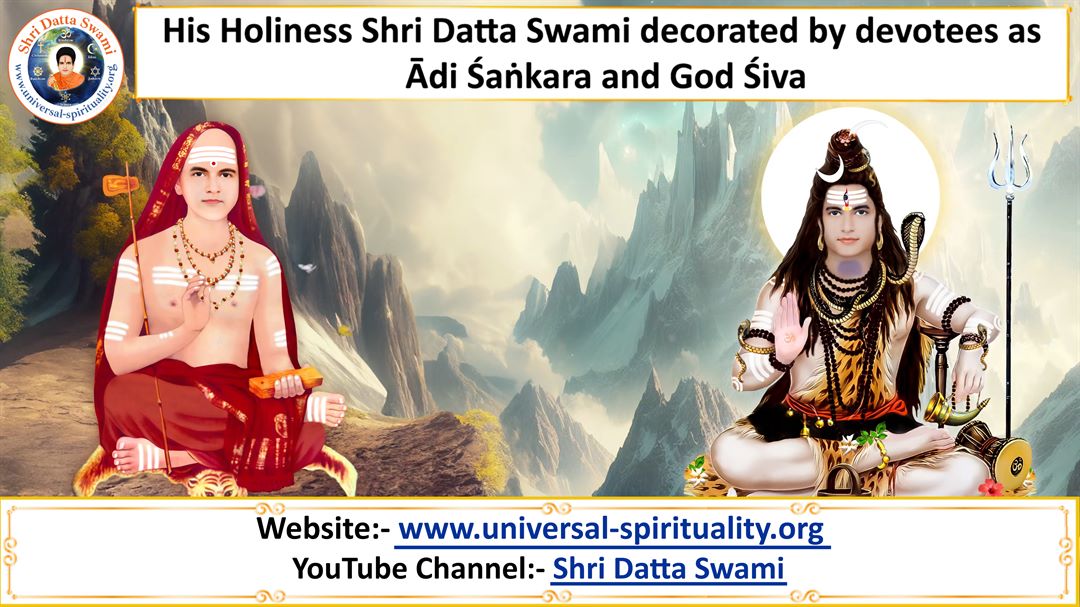
03 Sep 2024
[Prof. JSR Prasad asked:- Sāṣṭāṅga namaskāram Swami. Shankara condemned Purva Miimaamsaa and threw it out of the spiritual line. What is the reason for this? - At Your holy lotus feet, J.S.R Prasad]
Swami replied:- This is the most unfortunate affair. Correctly interpreted Puurva Miimaamsaa is actually the highest spiritual stage and is higher than the stage of knowledge of Shankara (Jnaana Yoga). But, such Puurva Miimaamsaa is thrown out of the spiritual path because Puurva Miimaamsaa misinterpreted the Vedic words and concluded in the exactly opposite side of the truth. This false interpretation is followed blindly by various generations without inquiry of the meanings of the words and this resulted in the ruin of correctly interpreted sacrifice or Yajna. Otherwise, Karma Yoga or practical devotion of Puurva Miimaamsaa is far far higher than the theoretical Jnaana Yoga (knowledge) and Bhakti Yoga (devotion). Devotion is related to mind and knowledge is related to intelligence. Hence, both these constitute theoretical phase only. Practice (karma) is far far better than knowledge (jnaana) and devotion (bhakti). The fruit is always linked to practice and not to the theory. Even though, theory is the source of practice, mere theory without practice is totally useless and cannot yield any fruit.
Puurva Miimaamsaa belongs to the topic of action or practice (Karmakāṇḍa) and this topic is about 80% of the Veda, which denotes the importance of practice or Karma Yoga. Knowledge (Jñānakāṇḍa) and devotion (Upāsanakāṇḍa) constitute only 20% of the Veda since they come under theoretical phase, which cannot yield the fruit directly. Hence, action is always far far higher than knowledge (jnaana) and emotion or inspiration (bhakti). Such practice is totally expressed in doing sacrifice or Yajna.
Detachment from the world comes by analysing death and initial detachment from worldly bonds is essential to make some trials to attach to God in the beginning stage. The Gita says that practice with knowledge is better than knowledge and knowledge is better than practice with ignorance (Śreyo hi jñānamabhyāsāt). Due to misinterpretation of the words, Puurva Miimaamsaa became the practice with ignorance. Shankara condemned this and proved that knowledge (Jnaana) is better than the ignorant practice (Abhyāsa) and here, Shankara condemned the ignorance only and not the practice. The practice is condemned by Shankara since it is associated with ignorance. Shankara has no grudge against the practice without ignorance.

Shankara approached Kumarila Bhatta with full regards, who is for both knowledge and practice (Jñānakarma samuccaya vāda). The approach of Shankara to Kumarila Bhatta with all respects shows that practice with knowledge is better than mere knowledge. If you take Puurva Miimaamsaa (Karmavāda) and Kumarila Bhatta (Jñāna Karma Samuccaya Vāda), practice (karma) is common in both the philosophies. But, karma mixed with ignorance becomes the worst, whereas karma mixed with knowledge is the best. In between these two, mere knowledge (Jnānavāda) stands. Unfortunately, Kumarila Bhatta is mentioned under Puurva Miimaamsaa! Mere milk without sugar (Jñānavāda) is better than milk mixed with poison (Puurva Miimaamsaa or Abhyāsa). Then, milk mixed with sugar (Jñāna Karma Samuccaya Vāda of Kumarila Bhatta) is better than mere milk (mere knowledge or Jñānavāda of Shankara). Shankara condemned only the ignorance (poison) of Puurva Miimaamsaa and did not condemn the karma (milk). But, when poison is mixed with milk (ignorance is mixed with practice), He has to condemn the poisoned milk totally. By this, scholars mistook Him as opponent of mere milk (mere karma) also. He showed a lot of respect to Kumarila Bhatta, whose argument is knowledge mixed practice (sugar mixed with milk). This shows that Shankara is against the poison only and not against mere milk or milk mixed with sugar.
Now, let us examine how the practice is poisoned with ignorance of the Vedic words in the absence of stress on knowledge of the Veda:-
1) The first hymn of the Rugveda says that the receiver or havaniiya (inert fire receiving the ghee offered) is also supplier or hotaa of the ghee. But, the inert fire cannot supply the ghee to itself and a non-inert person, hotaa, is supplying the ghee to the inert fire (Agniṃ… hotāraṃ).
2) The hotaa or supplier of ghee is confirmed as a non-inert person by two more words, which are – Purohitam and Ritvijam. Both these words mean the non-inert priests only. Hence, the conclusion is that not only the hotaa (supplier of ghee) but also the havaniiya (receiver of ghee) is the same non-inert person, who is supplying ghee to himself.
3) Since no human being drinks pure ghee, the word ‘ghee’ shall be taken as ghee-associated food as per the implied sense or Lakshanaartha (as we call the seller of apples by the name of apples). By the same logic, we can call the possessor of hunger-fire as fire. A hungry guest is called ‘Vaishvaanara’ fire in the Veda (Vaiśvānaraḥ praviśatyatithiḥ…). The same hungry guest can also be simply called as ‘fire’. When such hungry guest happens to be the Sadguru, we can call Him ‘Agni’ (fire). Such Sadguru is to be fed first in the sacrifice and Sadguru can be called as ‘Agri’ (means to be fed in the beginning). The word Agri became ‘Agni’ and this justifies that the Agni mentioned is the hungry Sadguru, who is eating the ghee-associated food with His own hand (hence, Sadguru is Hotaa) and His hunger fire is receiving the ghee-food as receiver or Havaniiya. The final essence is that the Sadguru, who is the chief priest is fed in the beginning of the sacrifice and since He is eating the food with His hand, He becomes Hotaa and since His hunger fire is receiving the food, He becomes Havaniiya. In this way, the hymn is interpreted without any absurdity.
4) The physical fire can be Laukikaagni or Bhautikaagni lit with the help of sticks or can be Vaidyutaagni lit by using the electric instrument. This physical fire is meant for cooking food, which is of eight or twelve types (Aṣṭākapālaṃ… Dvādaśkapālaṃ caruṃ - Veda) and hence, it is called the instrument to perform sacrifice (Yajna saadhanam).
5) The hunger fire is the divine fire (Devataagni), which is to be worshipped (Yajñopāsyaḥ) by supplying ghee-food and it is mentioned so in the Gita (Ahaṃ vaiśvānaro bhūtvā – Gita). This means that feeding the hungry Sadguru (Vaishvaanara fire) in the beginning with ghee-food prepared by using the physical fire in the lunch time after a continuous seminar on the topics of spiritual knowledge is the total essence of Yajna, which is the practice (karma) associated with knowledge. Such right practice is the true Karmakāṇḍa, which must be the topmost important stage.
6) The practice associated with ignorance is to burn the ghee in physical fire (taking ghee as pure ghee and fire as the physical fire). If the fire-god (Agni deva) appears in the fire altar and if the ghee-food is supplied to him for eating, then only the ghee-food is offered to fire-god. Burning the ghee-food or ghee in the inert fire (Bhuutaagni) cannot be feeding the fire-god. Shankara did not condemn the sacrifice (Karma Yoga), but, condemned the ignorant performance of the sacrifice (Puurva Miimaamsaa). Hence, the Gita says that the sacrifice must be done after associating with correctly interpreted Vedic words (Jñātvā kurvīta karmāṇi).
It is funny to think that the Jnaana Vaada of Shankara opposes Karma Vaada of Puurva Miimaamsaa. Knowledge can oppose only ignorance. Knowledge (Jnaana) opposing action (Karma) means that knowledge is opposing the background - ignorance of that action. If the action is having good background of knowledge, knowledge cannot oppose such action. Light and darkness oppose each other. But, the light does not oppose an object present in darkness. Hence, the action associated with ignorance is opposed by knowledge means that the knowledge is opposing the ignorance only that is associated with the action.
★ ★ ★ ★ ★